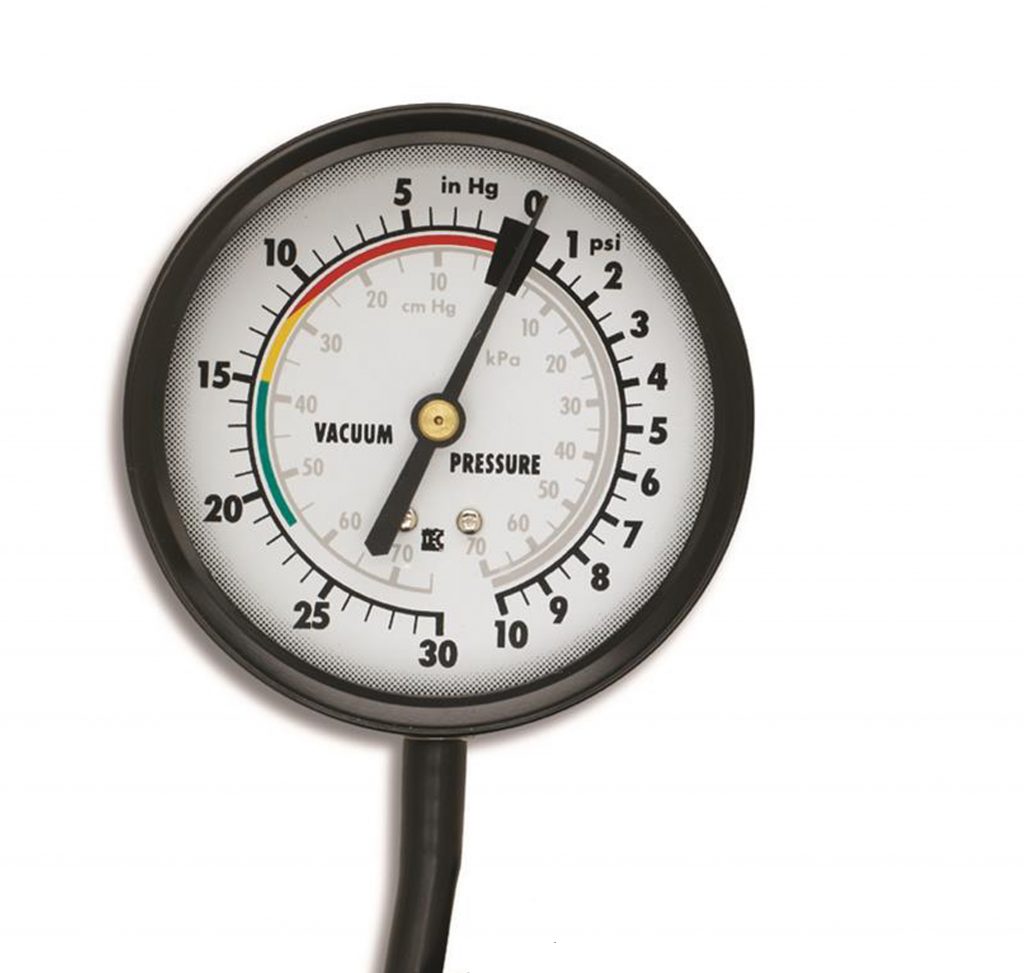
Can you give me a short explanation of what inches of mercury is and how it is measures manifold vacuum? I just don’t understand it. Thanks!
J.J.
This can sometimes be a confusing bit of measurement since many hot rodders think that engine vacuum is expressed in psi—which it is not. We’ll go over all of this and if we do a proper explanation, this will all make sense.
Measuring Pressure
Let’s start with a standard measurement of pressure. Atmospheric pressure is the measurement of the force created by a column of air that extends from ground level to the top of the Earth’s atmosphere. While air is considered light, it still has mass and when you consider that our atmosphere reaches up to roughly 100,000 feet above the Earth’s surface, this column of air creates pressure.
This pressure is measured in various ways. In America, the most common is psi, or pounds per square inch. The standard pressure measurement at sea level is 14.7 psi. This pressure can also be expressed in millibars—a metric measurement that is roughly equivalent to one-thousandths of standard atmospheric pressure.
Another typical measurement of atmospheric pressure is called inches of mercury. The scientific abbreviation for mercury is Hg, so inches of mercury would be expressed as “Hg.
You may have heard of inches of water as a pressure measurement used in flow benches. This is the amount of pressure needed to move water in a tube to a given level measured in inches. For example, 28 inches of water is generally used as the standard pressure used to measure airflow volume in cubic feet per minute (cfm) on a flow bench.
Water is far less dense than mercury, which means that 28 inches of water is only slightly more than two inches of mercury. Another way to look at this is that it takes a little more than two “Hg (2.03 “Hg to be exact) to equal one psi. So a reading of 14.7 psi would be equal to 29.92 “Hg.
All of these values are just different ways to express pressure. So essentially, both 14.7 psi and 29.92 “Hg are equivalent to atmospheric pressure at sea level. This is called standard pressure.
If we were to use an atmospheric pressure gauge at sea level, it would indicate 14.7 psia (we’ll explain what the “a” means in a moment). Then if we drove up into the mountains near Denver at 5,000 feet of altitude and read the pressure gauge again, it would indicate a much lower pressure of 12.2 psia or 24.8 “Hg. This is because as you climb the mountain, that column of air above you is now shorter, exerting less pressure. Eventually if you were to fly beyond the farthest point of the Earth’s atmosphere, the pressure would be zero.
In the above example we expressed pressure as psia which stands for pounds per square inch absolute. This tells you that the gauge is reading in absolute pressure, where again, if you were at the edges of space, the gauge would read zero.
Automotive gauges measure pressure above (or below) atmospheric pressure. This means that again at sea level, an oil pressure gauge would read zero pressure when exposed to the atmosphere. While rarely expressed this way, the technically correct gauge pressure is expressed as psig to indicate gauge pressure as opposed to absolute pressure (psia).
Understanding Vacuum Gauges
If your eyes have not quite glazed over completely with all this techno-babble—good for you!
Now we can get to inches of mercury on a vacuum gauge. We’re not sure why inches of mercury was chosen except that in the early days of aviation, manifold pressure was always expressed in “Hg. For early supercharged aviation engines, the manifold pressure is indicated on a gauge in inches of mercury.
How Vacuum Relates to Your Engine
Engine vacuum is also expressed in inches of mercury. Gasoline engines operate by restricting air intake with a throttle. An engine at idle with the throttle nearly closed will generate a significant amount of manifold vacuum. A stock V8 production engine will generally idle at anywhere from 14 to perhaps 18 “Hg. Performance engines generally use longer duration camshafts that include more overlap. This is where the intake and exhaust valves are open at the same time and this contributes to a lower intake manifold vacuum. Idle vacuum can be used to evaluate the quality of idle tuning. Improvements such as adding additional timing can raise the manifold vacuum.
As a result, we can use a vacuum gauge or some kind of pressure gauge to evaluate the state of engine operation. You may have seen vacuum gauges for cars where the gauge is split into three regions: green (high), yellow (medium), and red (low) vacuum readings. Many years ago, these gauges were popular for people to monitor throttle opening to help them improve fuel mileage driving habits. The more you could keep the throttle near closed, the better the fuel mileage.
If we haven’t numbed your brain completely, you now have a richer knowledge base with which you can mesmerize your friends.

After rebuilding an engine we measure crankcase pressure to track ring seating,or compression blow-by.
Nice article Jeff. Easy to read way of saying things.